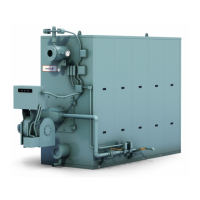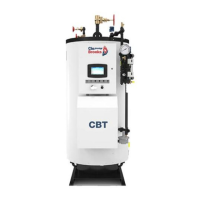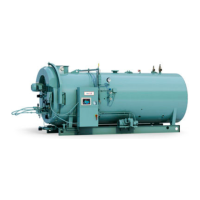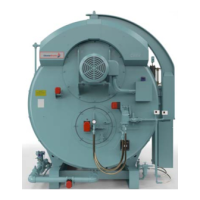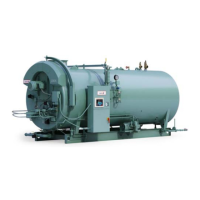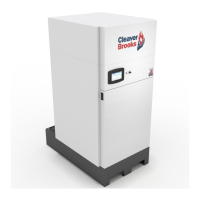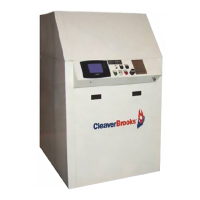Inspection and Maintenance Chapter 7
750-177 7-3
D. Upper Pass Cleaning
Upper pass access is gained through removal of the inner and outer side casing. To remove the outer casing
panels, first disconnect and remove any electrical conduit, boxes and brackets attached to the side outer
casing. Match mark the outer panels for repositioning. Remove screw (if installed) from frame above each
outer panel. Starting with center panel, slide panel up, swing bottom of panel away from boiler and then slide
down from the upper frame and set panel aside. After the center panel(s) are removed, the end panels can be
slid (approximately 1") towards the center until they free from the corner frame and then removed in the same
manner as the center panel(s). It there are only two outer panels (Models 150 through 350), then slide one
end panel further into the corner frame to allow the other panel to slide free from the corner frame. If
obstructions are present, such as the gas train, there may not be enough room to slide the panel out from
under the upper frame. In this case, unscrew the upper frame from the roof and side frames and remove it also.
Match mark all inner casing panels for repositioning later. Inner casing panels must be removed in sequence
starting from either end. Remove nuts, washers and clamp angles from the end and bottom of panels. Remove
nuts, washers and bolt bars from vertical seams. Loosen nuts on top clamp angles but don't remove until panel
is ready to be removed. Inner casing panels can not be removed by pulling panel straight out from boiler
because of a 1" gasket retaining strip that overlaps behind the panels. Remove inner casing panels by sliding
or angling panel away from remaining panels until the 1" retaining strip has cleared panel and then panel can
be removed and set aside.
After removing the inner side casing, the pass cover plates (2nd pass only) must be removed. The cover plates
are screwed together and are held in place by tabs inserted between the tubes. Remove the insulation by
starting at one end and carefully rolling it up. The insulation blocks can now be removed from the pass
opening. Keep the insulation blocks in order once they have been removed so they can be re-installed in the
same position. Insulation is removed from the 4th pass in the same manner.
Now that the 2nd (left side) and 4th (right side) pass openings are exposed, cleaning can be done in the same
way as the furnace area. Since the 3rd pass is only open on the ends, cleaning is done by pushing a wire
brush mounted on a long handle through from each end. Since the arc of movement is restricted, cleaning the
3rd pass must be done from both sides of the boiler. The fifth pass is cleaned from above the tubes. As in the
furnace, loose material should be removed by vacuuming after brushing. The pressure vessel should be
inspected for any signs of deterioration after cleaning.
The flue outlet and stack should also be inspected annually and cleaned as necessary. Commercial firms are
available to perform this work. The stack should also be inspected for damage and repaired as required.
Once everything has been cleaned and inspected the boiler can be put back together. Install insulation blocks
in the 2nd and 4th pass openings in their previous positions. Spray adhesive on tubes above and below pass
opening and install blanket insulation over opening. Install cover plates on 2nd pass (left) side only. If any
insulation was removed from under the tubes at bottom of boiler it should be replaced at this time.
Prior to installing the inner casing, inspect studs on boiler and bolt bars for any thread damage. Any damaged
threads should be cleaned and chased with a 3/8"-16 die. Apply a small amount of Cleaver-Brooks "Never-
Seez" (p.n. 797-1814 or 797-1816) on each stud.
Before the inner casing can be installed, the old gaskets must be removed from the panels and around the
perimeter of the boiler and replaced with new ones. After removing the gaskets, the surfaces should be cleaned
to allow the new gasket to seal properly. The gasket around the perimeter of the boiler should be one piece
with the ends overlapping side by side somewhere along the upper (roof) surface. A small amount of silicone
will be required to fill gaps and valleys where the gasket crosses. This includes the roof to end wall seams and
the base angle to end wall gaps. It is important that the entire gap between the end wall and the base angle
be completely sealed. The seal along the base of the end wall should also be checked and resealed if
necessary. The gasket should be positioned to the inside of the studs with a 1/4" gap between the studs and
the gasket.
Install gasket on side casing panels so it extends past the top and bottom by 1/4" or more and 1/16" to 1/8"
out the back at the top and bottom of the panel. (See Figure 7-1). Starting from one end, set panel edge 1/8"
to 1/4" from the studs on the end wall. Install the first lower clamp angle over the respective studs, install
washers and start nuts. Any nuts that are difficult to install should be replaced. Place the upper clamp angle
A
B
